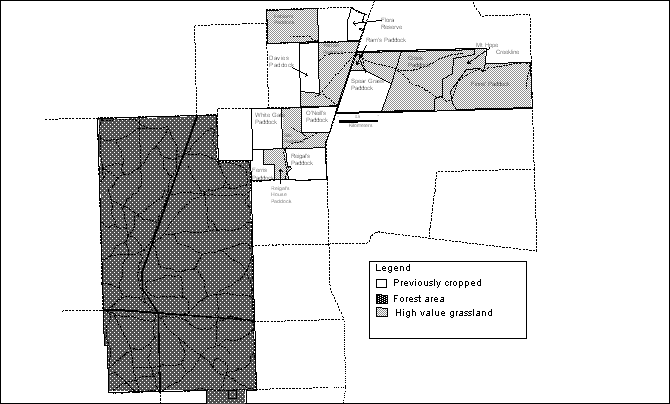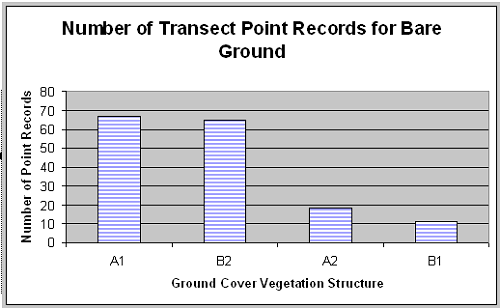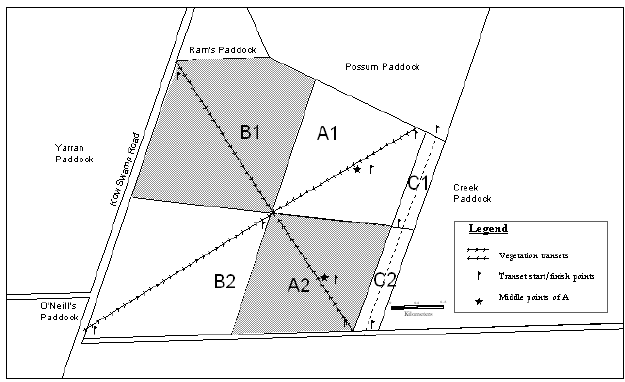
|
Our Valuable Native Grasslands, Better Pastures Naturally Proceedings of the Second National Conference of the Native Grasses Association |
Experiences Managing Terrick Terrick National Park
Ranger in Charge, Kerang , Parks Victoria
Abstract
A wide range of innovative and adaptive management techniques have had to be introduced into the management of the Terrick Terrick National Park to sensitively manage potential threats to the northern plains grasslands, grassy woodlands and indigenous heritage sites in the park.
Manipulating the timing and location of sheep grazing has enabled grassland values to be enhanced and weed infestations to be controlled. Controlled use of fire has seen changes in low value grassland structure and an increase in biodiversity. Rabbit and other pest control techniques have had to take account of non-target species, the creation of bare soil areas and indigenous cultural sites.
Adaptive management regimes are essential in newly created grassland reserves to enable the researching and collection of information vital to the long-term management to protect and enhance grassland biodiversity.
Introduction
Terrick Terrick National Park was included in Schedule two of the National Parks Act 1975 (Vic.) as a result of the National Parks (Amendment) Act 1998 (Vic.) and was proclaimed on 10 November 1998.
The park was created following the acquisition of a 1277 ha. grassland property adjacent to the former Terrick Terrick State Park by the Government. The property contains significant remnants of the endangered Northern Plains Grassland community and many threatened species. The former State Park and this recently acquired grassland property were combined to become the new Terrick Terrick National Park.
Parks Victoria commenced management of this property in October 1997 with the main interim focus being the commencement of pest plant and animal control and replacement of 23.5 km. of derelict boundary fencing.
Vegetation and faunal habitat assessments were carried out in 1998/99 to aid management and form base data for future reference. Grazing guidelines were also formulated to assist management of the grassland for both flora and fauna. These guidelines must remain adaptive, as changes may be required as knowledge and results from applied research come to hand.
Generally speaking, a `status quo' management regime has been adopted, ie. Sheep grazing at pre acquisition rates with records kept for stock numbers and paddock movements. Grazing guidelines were also formulated to assist management of the grasslands for flora and fauna protection and enhancement. The grazing guidelines form an important component of the Interim Management Statement (1998) which must remain adaptive, as changes may be required as knowledge and results from applied research come to hand.
A Draft Terrick Terrick National Park Management Plan has been prepared (2001) and is currently awaiting release for comment.
Research Projects
The Interim Management Statement identifies research that aids the future management of native grassland as one of the key medium term directions. In keeping with this direction, Parks Victoria has entered into partnerships with research institutions in order to carry out further applied grassland research that will assist future management.
Grazing regimes and the use of fire to reduce biomass and maintain an open structure are key focuses for this research. The park staff is currently carrying out other research initiatives.
The use of Fire to improve grassland structure and native species diversity
Terrick Terrick National Park grassland contains a number of paddocks that have been previously cropped and therefore are rated as having low conservation value in their current form. Map. 1.
Map 1. Terrick Terrick National Park Vegetation Values Map

Spear-grass (92 ha.) is one of these paddocks.
The purpose of the trial burns in this low conservation value paddock (recently cropped) were to see whether annual burning would improve the overall grassland structure and in time increase the native species component. To evaluate the outcome of these burns, the seven permanent vegetation quadrats located within this paddock will be closely examined for changes to species composition and their cover abundance. This, together with the transect monitoring, will be carried out pre and post burns.
The information that follows only relates to one burning cycle and so the results must be viewed with some caution until further burns and monitoring have been carried out.
The paddock was divided into four equal sections, each containing permanently marked vegetation quadrats (Lunt et al 1999). A one-hundred metre strip across the eastern end of the paddock was excluded from fire to act as a control plot.
Two diagonally opposite areas were control-burnt in April 2000 (Map 2) and the remaining diagonally opposite areas were burnt in April 2001. Six one hundred point structure transects were carried out prior to burning. Table 1 (Pre 2001-burn structure)
Grassland structure along these transects was re-evaluated after the respective burns.
Grazing exclusion plots (6m²) will be erected (post-burning) in the two areas burnt in April 2001 (three in each area) and one in each control area to enable evaluation of the effect post burn grazing has on vegetation structure and species survival. Exclusion plots were not placed in the burnt areas of 2000 and so it is not possible to determine the effect grazing had on the result.
The results of the April 2000 burn relating to grassland structure can be clearly seen when comparing the bare ground areas in Table 1 with the pre April 2001 burn. The litter areas have not shown similar results due to the method of defining litter. The litter recorded in the post burn areas (April 2000) constituted only a few dry grass stems, whereas the litter in the pre burn areas (April 2001) was consistently over 25 mm thick. Fig. 1 (Bare Ground Transect Point Records
Table 1 - Total Number of Point Records along Transects: A1, B2, A2 & B1
Twelve Months After Burn April 2000 |
Pre Burn April 2001 | |||
Transect A1 |
Transect B2 |
Transect A2 |
Transect B1 | |
Bare Ground |
67 |
65 |
18 |
11 |
Litter |
46 |
63 |
65 |
65 |
Summer Grass |
23 |
10 |
23 |
40 |
Winter Grass |
18 |
13 |
18 |
21 |
An.native Herb |
0 |
0 |
0 |
1 |
An.exotic Herb |
1 |
2 |
2 |
1 |
Per.native Herb |
0 |
0 |
0 |
1 |
Per.exotic Herb |
0 |
0 |
1 |
0 |
An.exotic Herb |
2 |
0 |
2 |
0 |
Note: Litter recorded in A1 and B2 constituted only a few dry grass stems, whereas litter in A2 and B1 was + 25 mm thick

Fig. 1 Transect Point Records for Bare Ground in Spear-grass Paddock.
It is proposed to burn all four sections again in March/April 2002. It has been suggested that a late spring burn of the sections burnt in 2000 would be beneficial to reduce the medic species that are prevalent. A large amount of medic seed was visible on the soil surface in these sections in April 2001. A visual inspection, weather conditions and resource availability will determine action this year.
Fauna Habitat Manipulation.
A total of twenty-three kilometers of derelict boundary fencing was replaced in May/June 1998. Approximately 1500 old cypress pine and box fence posts were removed and stock piled.
After carrying out over twelve months active search for fauna under an old fallen down fence line in Finn's paddock, it was clear that many of the grassland fauna utilise these posts for shelter sites. Species that were recorded utilising these old fence posts include: Curl snake, Striped and Olive Legless-lizard, Eastern Brown Snake, Boulengeri's Skink, Grey's Skink, Tessellated Gecko, Spotted Marsh-frog, Common Froglet and Fat-tailed Dunnart.
Twelve hundred of these old fence posts were placed in the grassland in May 2000 adjacent to each of the ninety-eight vegetation quadrats. Between 10 and 14 posts were placed near each quadrat (6mt. from each quadrat). A research student from CSU looked at utilisation of these posts by fauna as part of his Honours project, commencing in June 2000. This research is currently being evaluated and in the write up stage, nearing completion.
These posts appear to be sought after for shelter and breeding sites for a large number of the grassland fauna, especially when associated with deep substrate cracking. It may take a number of years for the conditions (suitable deep cracking) under these posts to become suitable over-wintering sites for many of the reptiles.
Pulse Grazing of Grassy Woodland.
Numerous areas of grassy woodland occur in the Terrick Terrick National Park Grassland. Most of these areas are relatively small and contain only mature box and buloke trees in a state of senescence. The lineal riparian woodland area along the Bendigo/Mt.Hope Creek contains predominantly mature Black box and some young Red Gum along the margins of the Creek.
These areas have historically been included as part of the grazing of the overall paddocks. The woodland areas also contained a high rabbit population, which together with the sheep grazing has traditionally had a major impact on the establishment of native plants. These combined effects resulted in a loss of recruitment of woodland trees and shrubs in these areas.
In 1998 these woodland areas were fenced off from the adjoining grassland and managed as distinct areas. An intensive rabbit control program commenced in 1999 to destroy rabbit harbour ( burrows, warrens) which reduced numbers dramatically.
However, after 12 months of grazing exclusion the grassland in the Buloke/Box woodland areas showed no visible regeneration of trees and shrubs. Sheep were then re-introduced to reduce grass biomass and open the grassland structure. Results of a combination of rabbit control and pulse grazing has resulted in significant amounts of Box and Buloke regeneration (both seed and suckers).
Further pulse grazing is now much more difficult to achieve without protecting juvenile plants that have responded to this technique.
From experience young Box trees are stripped and severely damaged by sheep when first introduced to the area for pulse grazing. Therefore, it is very important to check the paddock for regeneration prior to their introduction. Short-term protection of these seedlings is required to aid their survival.
Pulse grazing within the woodland area of Bendigo/Mt.Hope Creek has not been required due to the grassland structure and recent flooding which eliminated all grass within the flood zone. It is anticipated that there will be a significant flush of tree/shrub regeneration as a result of this recent flood.
The exclusion of grazing from grassy woodland areas that have been historically grazed has in many cases led to a reduction in biological values. Pulse grazing is a valuable tool that enables the manager to maintain a grassland structure that allows both regeneration and provides the necessary habitat for associated fauna.
Introduction of a Water Cart to improve grazing management and weed control
Terrick Terrick Grassland is divided up in numerous paddocks, a number of which lack water and therefore are difficult to graze efficiently as sheep require access to water. Also, a number of paddocks have sections, which are dominated by grassy weeds. Grazing is always intensified around a water supply point. This initiated the concept that by moving watering locations grazing intensity can be manipulated.
A water cart was designed to trial the effect of moving water locations to assist in biomass reduction and grassy weed control. This can only be carried out where there is the ability to restrict sheep access to current watering points and paddocks where water is not provided. This water cart will also be useful at other grassland reserves where water is currently not available.
The water cart is designed to carry 4500 litres of water with the ability to fill directly from dams and other water bodies via an on-board quick-fill pump. Drop down water troughs are located on either side of the water cart, which are gravity fed from the tank. Only one person is required to manage all aspects of the water cart operation.
The water cart is now ready for trial use and Parks Victoria are seeking interested researchers to set up an appropriate research trial to determine it's effectiveness in improving grassland values.
Pest plant and Animal control projects
Considerable pest plant and animal control works are carried out within Terrick Terrick National Park annually.
Catchment and Land Protection (CALP) weeds have been initially targeted due to our legal requirements and as part of Good Neighbour programs within the area. Targeted weed species include;
- Wheel Cactus,
- Boxthorn,
- Horehound,
- Patterson's Curse,
- Golden Thistle,
- Bathurst Burr,
- Stemless Thistle,
- Soursob,
- St Johns Wort
- Spear Thistle.
- Peppercorn trees and Fig trees have also been removed from the Park where possible.
Patterson's Curse is now becoming a significant weed in the grassland areas with recent infestations recorded on gilgai mounds in high quality paddocks. St Johns Wort is a new arrival, being recorded along the roadside adjacent to the grassland.
Fox control, by use of buried poisoned liver baits is carried out each spring and autumn to help reduce the impact of fox predation on native fauna. This program in is carried out throughout the whole Park. Bait stations are checked daily and all baits not taken are removed and destroyed.
Rabbits are a significant problem in localised areas within Terrick Terrick National Park. Rocky outcrops in the forest and grassy woodlands located in the grasslands are the areas most impacted upon by rabbits. The rabbit control program has begun by concentrating on the reduction of rabbit numbers in the grassland area followed by the Reference Area and its buffer zone within the forest.
Archaeological survey work has established that there is a high concentration of indigenous cultural sites within the granite outcrop areas of the park.
Harbour destruction is seen as the most effective long-term control to protect indigenous heritage sites and minimise the creation of exposed soil available to weed infestation. Harbour destruction has been carried out by implosion of rabbit warrens and individual burrows. This technique is carried out by qualified explosion experts and result in relatively little surface soil disturbance. Boxthorn removal also reduced rabbit harbour within these areas. Spotlight counts have indicated a dramatic reduction in numbers in these treated areas. Annual inspections of previously treated areas are carried out prior to the commencement of any new control works.
Conclusion
The management of Terrick Terrick National Park has required the introduction of innovative and adaptive techniques. These practices have aided the protection of both flora and fauna values in the park. Many of these techniques have also been useful in aiding the management of other reserves.
There is still much to learn relating to long-term management of grasslands, therefore it is hoped that results from research carried out at Terrick Terrick National Park will aid not only it's management but also grassland in all tenures.
References
- Landuse History and Grazing Management Guidelines (1999) University of Ballarat
- Parks Victoria (in prep.) Terrick Terrick National Park Draft Management Plan, Parks Victoria, Melbourne
- Terrick Terrick Conservation Reserve Interim Management Statement (1998), Trust for Nature (Victoria)
- Terrick Terrick National Park Environmental Information, Assessment and Mapping (May 1999) I.Lunt, P.Foreman and B.Wilson, Charles Sturt University
- Terrick Terrick National Park Habitat Assessment for Five Species of Threatened Vertebrates (1999) Peter Robertson, Wildlife Profiles Pty. Ltd
Map 2. Speargrass Paddock Burns

A1 and B2 burnt April 2000
A2 and B1 burnt April 2001
Total paddock area = 92.3 HA (230.6 acres)





